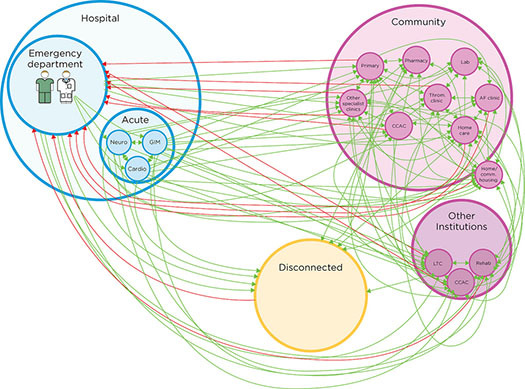
April 24, 2014
Design for Care

Design for Care: Innovating Healthcare Experience (Rosenfeld Media, 2013) is one of the first books fully dedicated to health care design and comes at a critical moment given the degree to which design is starting to be acknowledged as a legitimate profession within the context of health care institutions.
To transform health care by design, Peter H. Jones, the author of this book, emphasizes the use of systemic, service and strategic design. Systemic approaches to facilitate a participatory understanding of the complex and interdependent social kinds of problems that health care presents; human-centered service design tools to provoke the system and co-create innovative ideas; and strategic design to envision future scenarios to enable sustainable transformations.
From my previous experience working at an embedded design group within a large health care institution, I feel that this book accurately captures the value spectrum of design in health. As design remains a new field within the context of the hospital, medical culture values designers in multiple ways: we are seen as visual communicators, advocates for patient’s needs, aggregators of multiple perspectives, idea facilitators and creative problem solvers. It might be difficult to describe precisely our design role, since we are still establishing ourselves in this culture. This is why Design for Care is fundamental, as it introduces a new language for design within the larger realm of health care with designers actively engaged in new kinds of partnerships, challenging institutionalized some of the pre-existing power dynamics between patients and doctors.

Among several important themes in this book, the author considers rethinking care models and leveraging the role of the community to facilitate the experience of wellness in populations. Here, transformations in policy are considered in an effort to reconsider new business models that can, in turn, influence better care models that may ultimately define more positive health care experiences. The author presents this as a kind of funnel, suggesting that designers become more adept at spanning within this funnel, from the macro view (policy innovation) to the micro level (care experiences), understanding the interdependencies that arise from connecting across these different scales. In practice, designers often discover strategic long-term opportunities that can easily become jeopardized by short-term priorities.
To ensure sustainable health transformations, Jones highlights design solutions that effectively solve the wrong problems. For example, there are ‘visible’ challenges in health care — like waiting times, or fragmented care; a shortage of doctors and rising costs. Such visible problems , he argues, are merely symptoms of deeper interrelated causes. Design should avoid design opportunities that reinforce the current ‘sick-care’ system, by making it more efficient or disguising initiatives with a patient-centric rhetoric. The author proposes that service design tools should be complemented with systemic approaches in order to understand the complexity that characterize health care and intervene within the root causes of problems. Besides exploring the most common design tools like patient journeys, scenarios, storyboards and personas, Jones suggests proven new approaches with great design potential. The methods introduced — video-ethnographies, sense-making tools, Structured Dialogic Design (SDD) and Giga-Mapping — may allow designers to more successfully innovate in powerful spaces, like health policy and business models. It also balances the user-system continuum by introducing empathic approaches (capturing individual human needs, for instance) and coupling them with participatory tools to map out larger systemic challenges.

The existing network of disconnected atrial fibrillation (AF) services. AF patients flow chaotically among care providers.
For aspiring designers in this nascent field, this book addresses the basics: how to start designing in health or how to go about establishing an integrated health design group. The principles and theories are grounded in design practice and include case studies from a variety of sources, including IDEO and other design consultancies; students projects from OCAD and AHO Universities; and embedded design groups at the Mayo Clinic Center for Innovation and the Toronto Center for Innovation in Complex Care. Even though Jones’ research is mostly based in the United States and Canada, his conclusions are applicable worldwide. Possibilities for future research may include comparing international health design programs by exploring and contrasting initiatives from different countries (not mentioned in the book). This may include work from the Experience Based Design approach at the NHS in England, the Finish Innovation Fund (SITRA), Supplejack in New Zealand, the Human Experience Lab in Singapore, the REshape at Radboud University Medical Center in The Netherlands, DOT in Norway and many others that are still in the making. There has not been a comprehensive study that encompasses all of the health design initiatives, from a multi-national perspective. Until now.
Observed
View all
Observed
By Manuela Aguirre
Related Posts

Sustainability
Delaney Rebernik|Books
Head in the boughs: ‘Designed Forests’ author Dan Handel on the interspecies influences that shape our thickety relationship with nature

Design Juice
L’Oreal Thompson Payton|Books
Less is liberation: Christine Platt talks Afrominimalism and designing a spacious life

The Observatory
Ellen McGirt|Books
Parable of the Redesigner

Books
Jennifer White-Johnson|Books
Amplifying Accessibility and Abolishing Ableism: Designing to Embolden Black Disability Visual Culture
Recent Posts
Mine the $3.1T gap: Workplace gender equity is a growth imperative in an era of uncertainty A new alphabet for a shared lived experience Love Letter to a Garden and 20 years of Design Matters with Debbie Millman ‘The conscience of this country’: How filmmakers are documenting resistance in the age of censorshipRelated Posts

Sustainability
Delaney Rebernik|Books
Head in the boughs: ‘Designed Forests’ author Dan Handel on the interspecies influences that shape our thickety relationship with nature

Design Juice
L’Oreal Thompson Payton|Books
Less is liberation: Christine Platt talks Afrominimalism and designing a spacious life

The Observatory
Ellen McGirt|Books
Parable of the Redesigner

Books
Jennifer White-Johnson|Books

 Manuela Aguirre is a designer researching the role of design in empowering people to innovate public services — with a particular interest in a systemic approach to health and wellbeing. Her project Designing for Dignity won numerous recognitions. She was part of the Mayo Clinic Center for Innovation design team in Rochester, Minnesota. She now lives in Oslo, Norway.
Manuela Aguirre is a designer researching the role of design in empowering people to innovate public services — with a particular interest in a systemic approach to health and wellbeing. Her project Designing for Dignity won numerous recognitions. She was part of the Mayo Clinic Center for Innovation design team in Rochester, Minnesota. She now lives in Oslo, Norway.